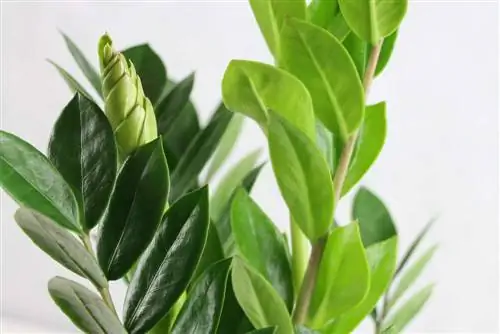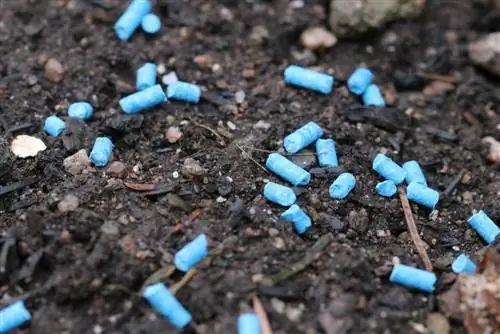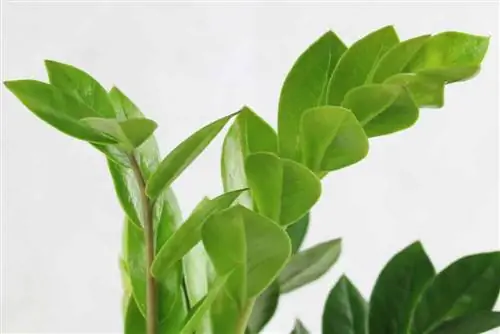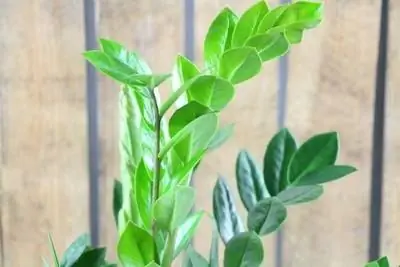- Author admin [email protected].
- Public 2023-12-17 03:39.
- Last modified 2025-06-01 06:48.
The Zamioculcas has a noble appearance due to its upright growth. The arrangement of the leaves is somewhat reminiscent of palm fronds. It is “almost” indestructible and does not require a green thumb. Perhaps it is also called the lucky feather because its posture is always lucky. It even copes wonderfully with poor lighting conditions. But what about us? How do we cope with their poison?
How poisonous is Zamioculcas?
Many plants that surround us like us contain substances in their leaves, fruits or roots that are toxic to us humans or our pets. Some of the plants are also poisonous in all their parts. However, if we banned all poisonous plants, the earth would look less colorful. That cannot be the solution to the problem. Rather, it's about knowing the toxicity of each plant and reacting to it appropriately. The Zamioculcas in particular, botanically Zamioculcas zamiifolia, can be found in many households and is therefore particularly easy to access for people and animals. It is slightly poisonous, so some caution is required when cultivating it. Of course, adults wouldn't be tempted to eat this plant. Ignorant little children are more curious and also like to put leaves in their mouths. Especially when there is no one around.
Toxic agents
Oxalic acid and calcium oxalate are the two substances that are responsible for the toxic effects of the lucky feather. They belong to the so-called dicarboxylic acids. These poisons are also released into water by the plant through the roots. If the lucky feather is watered abundantly and the water flows out of the pot holes, there is always a little of these poisons with it. The excess water that collects in the saucer or planter is therefore just as toxic as the plant itself. If this water is simply left standing, it could tempt pets. If they are thirsty, they could drink from it.
Are people at risk?
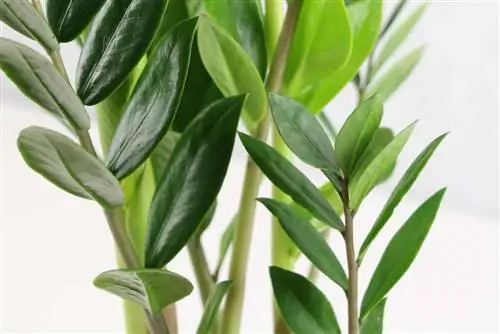
The lucky feather is not a big danger for adults. Especially not if the necessary protective measures are conscientiously observed when handling this plant. This room decoration poses a greater danger to smaller children. They are at a double disadvantage. On the one hand, they still lack knowledge of the toxicity and how to deal with it responsibly. Understandable, because they are still far too young for that. The fact that they are unpredictable and put everything in their mouths is more typical behavior for their age. Furthermore, the poison hits her harder because her body is still so small and it is still developing. However, life-threatening poisoning from this plant is unlikely.
Symptoms of poisoning
If the skin comes into contact with the Zamie, the poison can have the following effects:
- Redness of the affected skin area
- Swelling
- slightly burning feeling
If parts of the plant are ingested directly, for example because leaves are put in the mouth and eaten, the tongue and mucous membranes are attacked by the poison of the lucky feather. Calcium oxal crystals penetrate and cause mild symptoms of poisoning as with the skin but also additional symptoms:
- Redness, swelling and burning sensation
- Difficulty swallowing
- Nausea and vomiting
- Diarrhea
- Stomach cramps
Oxalic acid can also lower calcium levels in the blood serum, causing hypocalcemia. This can damage the kidneys through crystal formation. Other serious he alth problems caused by Zamioculcas are not yet known.
How quickly do symptoms of poisoning appear?
As soon as the toxins from Zamioculcas enter the human body or come into contact with the skin, they begin to work. The first symptoms appear relatively quickly. As a rule, the toxic effect only lasts for a short time. The course of poisoning is similar for our animal companions. They also suffer from the symptoms caused by the poison almost immediately. For you, too, the symptoms quickly subside on their own.
First measures in case of poisoning
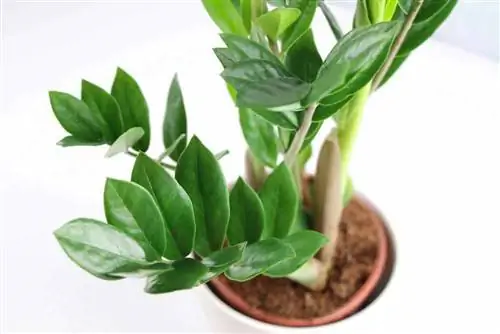
All parts of the Zamioculcas, which is also often called the cardboard paper palm, taste extremely bitter. Even the small child who puts the leaves in his mouth will quickly discover this for himself. Since most children of this age are known to like sweet things and few like bitter things, the eating pleasure will most likely end quite abruptly. The child will probably spit it all out quickly. This means that hardly any poison is absorbed and what little poison was in the mouth hardly had time to spread through the body. However, you should take some preventive measures:
- Rinse your mouth well
- Drink lots of water or tea
- Rinse eyes with lukewarm water if plant sap gets into them
- rinse affected skin areas with plenty of water
If, despite the low risk, the symptoms described above occur and there is no rapid improvement, you should see a doctor just to be on the safe side. Especially in children, it can help to alleviate the symptoms and make them bearable for the child. If your eyes are affected by Zamioculcas poisoning and there is no rapid improvement after rinsing with water, you should definitely consult an ophthalmologist promptly.
Note:
Milk can accelerate the absorption of the poison and should not be taken.
Is Lucky Feather toxic to pets?
Our pets and our houseplants share a living space. If animals can move freely through rooms, as is usually the case with dogs and cats, they can easily get close to the zamioculcas. This houseplant is also accessible to birds when they are let out to fly, and they may even land on it. But this beautiful plant is just as poisonous to animal friends as it is to humans. But how do you teach it to your pets? Therein lies the real problem. The knowledge that protects us cannot be conveyed to them. In addition, they too are sometimes curious, like small children. And just like these, you can't always keep an eye on them. A bird flying around can quickly drink water from the saucer. This would also cause it to absorb the toxic substances contained therein.
What symptoms of poisoning do pets show?
Cats in particular often like to nibble on plants. However, since this plant also tastes bitter and unpleasant to animals, there is little risk of them eating large quantities of it. If an animal still dares to do this, the following symptoms could quickly appear:
- swelling of the mucous membranes
- heavy salivation
- Difficulty swallowing
- Shortness of breath
- Vomiting
- Diarrhea
- Bleeding
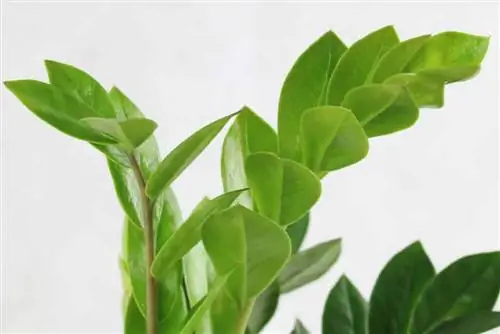
If the dose of poison taken is particularly high, kidney damage can occur. In most cases, however, contact with the lucky feather goes smoothly. In the majority of cases, you don't even need to see a doctor. As quickly as the symptoms appeared, they disappeared again. Of course, you can also see a doctor if you are very worried.
Cultivation Precautions
Many families with small children consistently avoid poisonous plants in their immediate living environment. This is a preventive decision that is certainly justified, even if not all poisonous plants are equally life-threatening. If you don't have small children or pets, you can choose more generously in favor of plants in this regard. Whoever decides to use this plant should do their research beforehand. Even minor damage to he alth does not have to be a problem if it can be easily prevented through appropriate measures.
- Weigh the purchase decision carefully
- obtain in-depth information about Glücksfeder
- Inform roommates about the toxicity
- familiarize yourself with symptoms and initial measures.
- wear plastic gloves when coming into direct contact with plant parts,
- Dispose of plant parts that have been cut safely
- Keep animals away
- Pour away the water from the coaster.
Poison control center
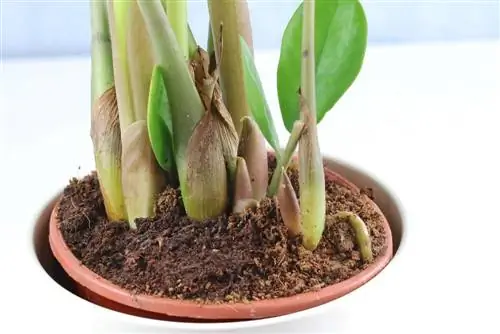
It usually provides free information about first aid in the event of poisoning. Since poisoning can be caused by different substances, it is important to provide as much detail as possible. This is the only way the poison control center can identify the “culprit” and give appropriate advice. The following information is particularly important:
- who poisoned themselves, adult or child
- Time of poisoning
- what caused the poisoning,
- what symptoms occurred
- what has already been done
Tip:
If you don't know exactly what a plant is called, then describe its typical characteristics as precisely as possible.
Berlin
Poison emergency call of the Charite / Poison emergency call Berlin
giftnotruf.charite.de
030-19 24 0
Bonn
Information Center against Poisoning North Rhine-Westphalia / Poison Center Bonn
Center for Pediatrics University Hospital Bonn
www.gizbonn.de
0228-19 24 0 and 0228 - 28 73 333
Erfurt
Joint Poison Information Center (GGIZ Erfurt) of the states of Mecklenburg-Western Pomerania, Saxony, Saxony-Anh alt and Thuringia in Erfurt
www.ggiz-erfurt.de
0361-73 07 30
Freiburg
Poisoning Information Center Freiburg (VIZ)
University Hospital Freiburg
www.giftberatung.de
0761-19 24 0
Göttingen
Poison Information Center-North of the states of Bremen, Hamburg, Lower Saxony and Schleswig-Holstein (GIZ-Nord)
www.giz-nord.de
0551-19 24 0
Homburg/Saar
Poisoning Information and Treatment Center, Saarland University Hospital and Medical Faculty of Saarland University
www.uniklinikum-saarland.de/giftzentrale
06841-19 240 and 06841 - 16 83 15
Mainz
Poison Information Center (GIZ) of the states of Rhineland-Palatinate and Hesse
Clinical Toxicology, University Medical Center Mainz
www.giftinfo.uni-mainz.de
06131-19 240 and 06131 - 23 24 67
Munich
Poison emergency call Munich - Department of Clinical Toxicology Klinikum Rechts der Isar - Technical University of Munich
www.toxinfo.med.tum.de
089-19 24 0
Vienna/Austria
Poisoning Information Center (VIZ) - Gesundheit Österreich GmbH
www.goeg.at/Vergiftungsinformation
+43-1-4 06 43 43
Zurich/Switzerland
Swiss Toxicological Information Center
www.toxi.ch
145 (Switzerland)
+41-44-251 51 51 (from abroad)

